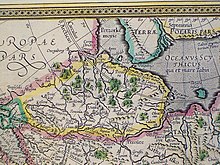| Russian conquest of Siberia | |||||||||
|---|---|---|---|---|---|---|---|---|---|
| Part of the territorial evolution of Russia | |||||||||
 Yermak's Conquest of Siberia, a painting by Vasily Surikov | |||||||||
| |||||||||
| Belligerents | |||||||||
|
Allied Indigenous Siberians |
Khanate of Sibir (until 1598) Daurs Bashkirs Yakuts Koryaks Chukchis Buryats | ||||||||
| Commanders and leaders | |||||||||
|
|
Kuchum Khan Daur prince Guigudar | ||||||||


The Russian conquest of Siberia took place during 1581–1778, when the Khanate of Sibir became a loose political structure of vassalages that were being undermined by the activities of Russian explorers. Although outnumbered, the Russians pressured the various family-based tribes into changing their loyalties and establishing distant forts from which they conducted raids. It is traditionally considered that Yermak Timofeyevich's campaign against the Siberian Khanate began in 1581. The annexation of Siberia and the Far East to Russia was resisted by local residents and took place against the backdrop of fierce battles between the Indigenous peoples of Siberia and the Russian Cossacks, who often committed atrocities against Indigenous Siberians.[1][better source needed]